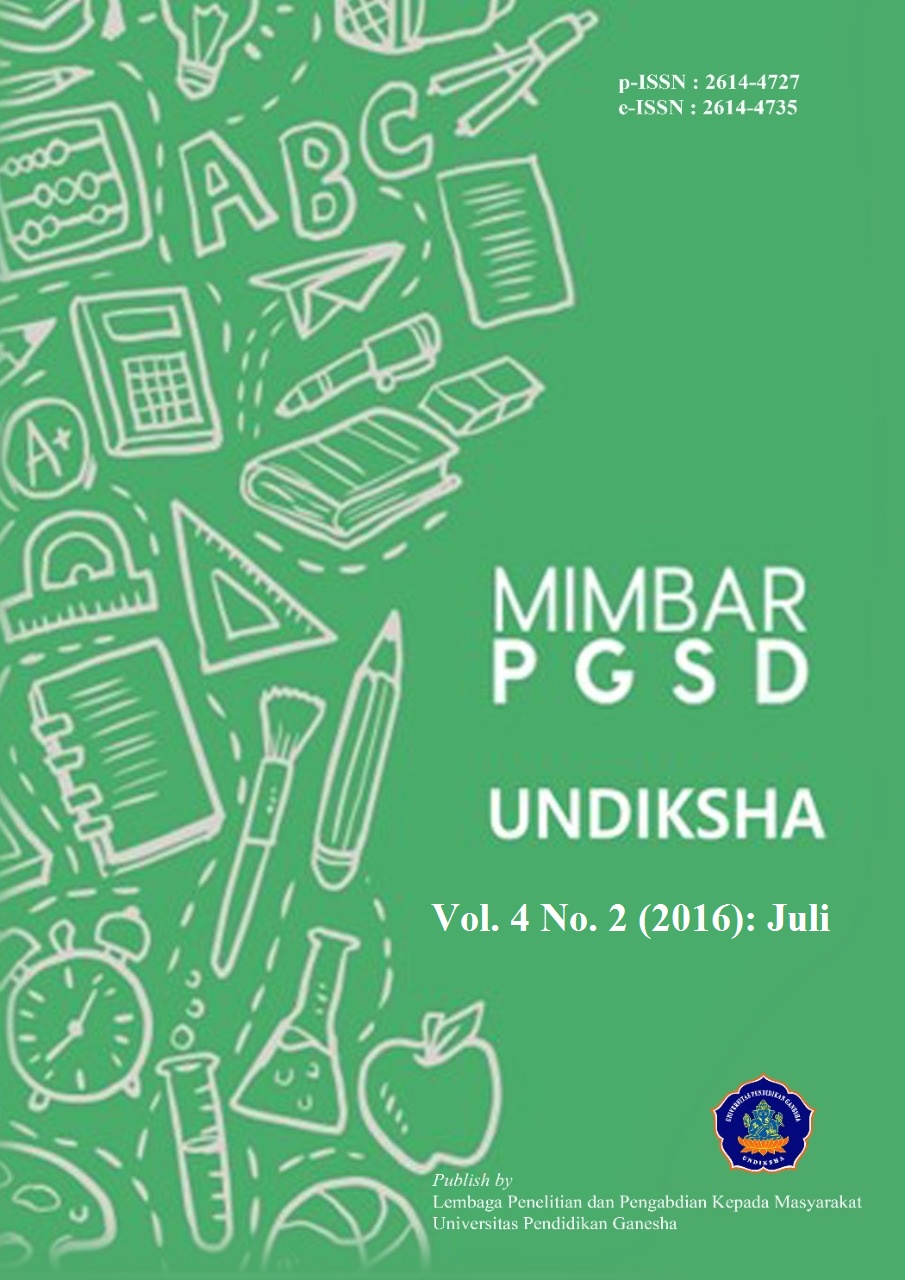PENERAPAN MODEL PEMBELAJARAN KOOPERATIF TIPE STAD UNTUK MENINGKATKAN HASIL BELAJAR IPA KELAS IV SD
DOI:
https://doi.org/10.23887/jjpgsd.v4i2.7673Abstract
Penelitian ini bertujuan untuk mengetahui peningkatan hasil belajar siswa pada mata pelajaran IPA kelas IV SD 2 Penarukan melalui penerapan model pembelajaran kooperatif tipe STAD. Jenis penelitian ini adalah penelitian tindakan kelas yang dilakukan melalui dua siklus, setiap siklus terdiri dari 5 kali pertemuan yaitu 4 kali pembelajaran dan 1 kali tes. Subjek pada penelitian ini adalah seluruh siswa kelas IV di SD 2 Penarukan yang berjumlah 20 siswa. Subjek belajar menggunakan model pembelajaran kooperatif tipe STAD dalam pembelajaran IPA. Objek pada penelitian ini adalah hasil belajar IPA siswa pada ranah kognitif dan model pembelajaran kooperatif tipe STAD. Data hasil belajar IPA siswa dikumpulkan melalui tes tertulis berbentuk objektif yang terdiri dari 20 soal. Hasil penelitian menunjukkan bahwa rata-rata persentase hasil belajar IPA siswa pada siklus I yaitu 72% yang berada pada kriteria sedang. Sedangkan pada siklus II rata-rata persentase hasil belajar siswa meningkat mencapai 85% yang berada pada kategori tinggi dalam pedoman konversi PAP skala lima tentang tingkatan hasil belajar. Berdasarkan hasi penelitian tersebut, dapat disimpulkan bahwa terdapat peningkatan hasil belajar IPA siswa melalui penerapan model pembelajaran kooperatif tipe STAD pada siswa kelas IV SD 2 Penarukan Kecamatan Buleleng kabupaten Buleleng Tahun Pelajaran 2015/2016.Kata Kunci : STAD, hasil belajar IPA
This research was aimed to find out the average of student’s result in science learning at fourth grade of SD 2 Penarukan by the implementation of cooperative learning model type STAD. This research was the classroom action research with two cycles, each cycles consist with five meeting, four for learning and once for doing test. The subject of this research was all students at fourth grade of SD 2 Penarukan that consist of 20 students. The objects of this research were student’s result in science learning at cognitive and cooperative learning model type STAD. Data of student’s learning in science was collected by using test method that was objective test consisting with 20 questions. The results of this research indicate that the average percentage of student’s result in science learning at first cycle is 72% which is in medium criteria. At second cycle the average percentage of student’s result in science learning increases to 85% which is in high category based on PAP five scales. According to the results of this research, concluded that there is average of student’s result in science learning by the implementation of cooperative learning model type STAD at fourth grade of SD 2 Penarukan Buleleng district Buleleng regency in academic year 2015/2016.
keyword : STAD, the result in science learning
Published
2016-07-20
How to Cite
., K. A. I., ., D. I. W. R. S., & ., D. I. K. D. M. (2016). PENERAPAN MODEL PEMBELAJARAN KOOPERATIF TIPE STAD UNTUK MENINGKATKAN HASIL BELAJAR IPA KELAS IV SD . MIMBAR PGSD Undiksha, 4(2). https://doi.org/10.23887/jjpgsd.v4i2.7673
Issue
Section
Articles
License
Authors who publish with the Mimbar PGSD Undiksha agree to the following terms:
- Authors retain copyright and grant the journal the right of first publication with the work simultaneously licensed under a Creative Commons Attribution License (CC BY-SA 4.0) that allows others to share the work with an acknowledgment of the work's authorship and initial publication in this journal.
- Authors are able to enter into separate, additional contractual arrangements for the non-exclusive distribution of the journal's published version of the work (e.g., post it to an institutional repository or publish it in a book), with an acknowledgment of its initial publication in this journal.
- Authors are permitted and encouraged to post their work online (e.g., in institutional repositories or on their website) prior to and during the submission process, as it can lead to productive exchanges, as well as earlier and greater citation of published work. (See The Effect of Open Access)















